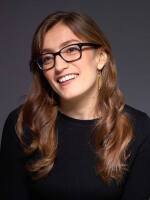Updated August 6, 2025 at 4:18 PM EDT
This story was originally published on Sept. 5, 2024, and has been updated.
Elysia Berman remembers the moment she realized her shopping was out of control. In December 2023, she ducked into a store to buy a pair of gloves. And she came out with a $600 coat she didn't need and couldn't afford.
"That was my breaking point," she recalls.
Berman, 35, knew she had an unhealthy relationship with shopping. So she decided to do something drastic. In January 2024, she began the no-buy challenge, a popular social media experiment that encourages people to buy less stuff. For a set time period -- in her case, a whole year -- she'd stop spending money on non-essential items. No clothes. No makeup. No home decor. Instead, she'd use what she had and buy second hand.
The challenge is harder than it seems. Berman, who is documented her no-buy journey on TikTok, had to break her habit of buying 10 to 30 new items a week. And as a fashion industry professional, she was surrounded by the temptation to shop.
By September 2024, Berman says she has saved tens of thousands of dollars, paid down a quarter of her debt -- and says her mental health has improved. "Essentially, I had gone through detox and withdrawal from the dopamine you get from shopping."
Anyone can try the no-buy challenge. Whether your reason is to curb spending, cut back on fast fashion or reduce your carbon footprint (about 10% of all carbon emissions come from the fashion industry, according to the United Nations), here are some tips to help get you started.
@elysiaberman My 2024 no-buy journey starts now! Are you doing a no-buy month or year? Share your experience in the comments! Inspired by creators like @Christina #nobuychallenge #nobuyyear #2024resolutions #sustainablefashion #debtfree ♬ original sound - elysiaberman
Create a "yes" and "no" shopping list
Grab a pen and paper and write down a list of non-essential items that you'll stop buying -- and continue buying -- for a set period of time. It'll help you pinpoint items you tend to overspend on, and be more intentional about what's really worth buying. It can also help you focus on the goals of your no-buy experiment.
"The no-buy rules are going to be different for everyone," says Berman. She knows she has a weakness for fashion, so her "no" column included clothes, beauty products, perfume, jewelry and bathing suits.
Your "yes" column should target items that enrich your life and encourage your hobbies, she says. Berman's list included fresh flowers, museum tickets, pilates classes and budget travel.
Set a timeline -- and the rules
Berman decided to do the no-buy challenge for a whole year. If that feels too restrictive, maybe try it out for a few months -- or even a couple of weeks.
You can also change the rules of the experiment to make it more fun. Sustainable fashion writer Aja Barber runs an online community where she encourages people to consume more mindfully. "I challenge people not to buy a single new dress this year. That forces people to be a little bit creative, but it doesn't entirely limit them," she says. "I've also challenged my readership to buy 50% of their clothing second hand."
Reduce your temptation to shop
In a world of flash sales and ads that follow you from site to site, the temptation to shop is everywhere. So limit your exposure to shopping deals -- and "get a grip on your social media," says Barber.
- Unfollow any social media accounts that persuade you to spend money, says Berman. That includes fashion influencers, stylists and clothing brands.
- Unsubscribe from the email lists of your favorite brands, says Barber. Getting daily or weekly updates about sales and price reductions is not helpful.
- Follow mindful consumption influencers and groups. Berman made a point to follow people who were also working on changing their spending habits. "They became almost like a support group," she says.
- Block websites where you tend to impulse shop. Berman did this with some of her top fashion sites at the start of her no-buy year. "That way, I wasn't even tempted to browse," she says.
Change your shopping habits
It's easy to overspend on fast fashion. But when you start to humanize its supply chain, you start to see that the amazing deal of, say, an $8 Shein dress, isn't so amazing after all.
Fast fashion is quick and cheap because companies cut every possible corner and cost, says Dilys Williams, director of the Centre For Sustainable Fashion at the University of the Arts in London. That often means using oil-based fabrics like polyester, which do not biodegrade, and factories that pollute and often drastically underpay or mistreat workers.
As a result of this system, humans are consuming more than ever, and the consequences are real, says Barber. There is a giant pile of discarded clothes in Chile's Atacama Desert that is so large it can be seen from space. And the beaches of Ghana have been overtaken with discarded clothes that have washed up on the shores.
So recalibrate your idea of what is normal when it comes to how much clothes cost. Support sustainable fashion brands. And understand the harms of fast fashion, says Barber.
Months into the challenge, Berman says that her no-buy journey has helped her consume more mindfully. And there have been other payoffs as well.
"I am very proud of myself," she says. "I've seen a new level of dedication and focus that I wasn't aware I was capable of before."
The audio portion of this episode was produced by Margaret Cirino and edited by Malaka Gharib. The visual editor is Beck Harlan.
We'd love to hear from you. Email us at LifeKit@npr.org. Listen to Life Kit on Apple Podcasts and Spotify, or sign up for our newsletter.
Copyright 2025 NPR



